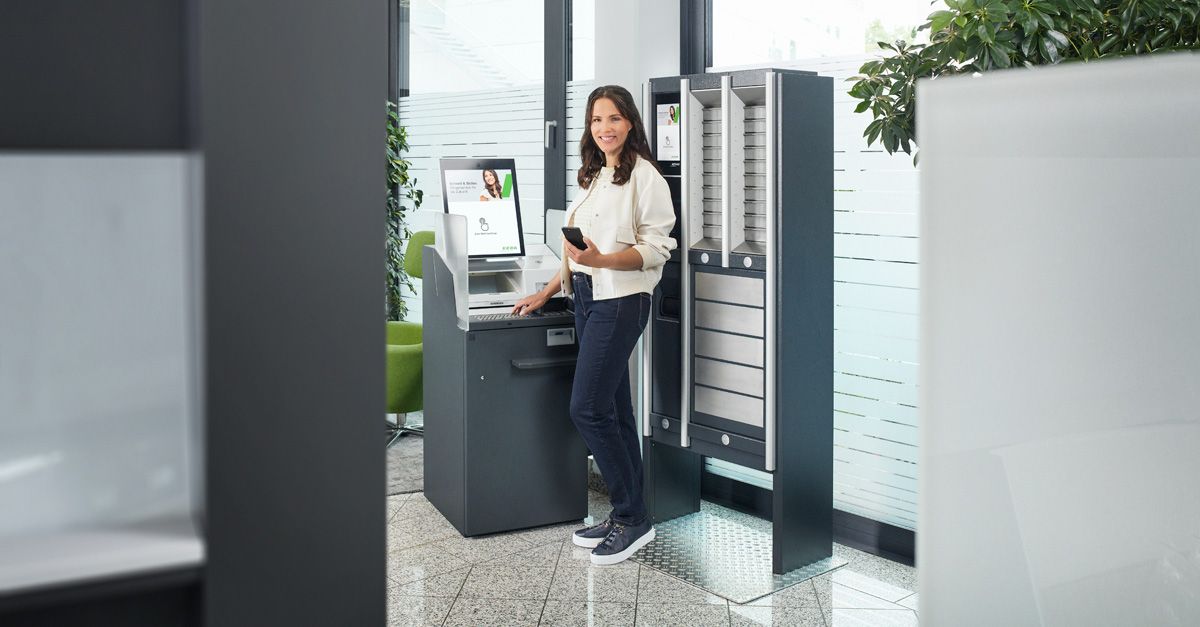From self-service to smart service: What customers expect from self-service terminals today
- 11.7.2025
- Reading Time: {{readingTime}} min

Contents
Smart self-service terminals that adapt to people - not the other way around
At KEBA, we've developed modern citizen terminals designed specifically for today’s evolving service expectations. These devices go far beyond traditional self-service terminals by combining user-centric design with intelligent technology—accessible, barrier-free, and easy to use:
User-friendly interface: Fully accessible and intuitive, certified by myAbility to be inclusive for all users.
Invoice scanning: No closed paper feeder—instead, a large A4 scanner allows documents to be simply placed on top.
Smart View: Our patented system only darkens the scanner area during the actual scan, leaving it fully visible before and after.
Open access: Users don’t need to reach into a “black hole,” making operation easy even with limited dexterity.
Privacy: Side panels on the housing protect users from prying eyes and ensure a discreet experience.
An Overview of KEBA's smart service terminal models
We’ve developed three smart service terminal models tailored to meet different organizational needs:
KeCity D10 A true all-rounder for banks and public institutions. With a user-friendly interface and features like eID reader, payment function, and printer, it allows for barrier-free, simple application processing directly at the terminal.
KeCity H10 Specially designed for secure, logged document handovers—24/7. It helps relieve staff by handling standardized services, such as passport collection.
KeCity Point Also known as the "Amt-o-Mat", this hybrid model combines the strengths of the D10 and H10—enabling both application submission and secure document handover in one integrated solution.
Where smart self-service terminals make a difference
Smart self-service terminals are being used across a variety of sectors. In banks, they enable customers to conveniently pay invoices directly at the terminal. They also offer video chat capabilities, allowing seamless communication with bank representatives. Additionally, customers can access a digital e-safe right from the terminal.
In municipalities, the terminals provide a wide range of practical functions. Combined with the H10 document module, citizens can collect official documents—quickly and independently—right at the terminal. They can also complete applications, such as registering a dog tax, directly on-site. Payment is processed immediately afterward, allowing the entire transaction to be completed in a single step.
"Traditional self-service is a thing of the past. Today’s customers don’t just want to handle things on their own—they want to do it easily, quickly, and without barriers."
Three real-life examples
These practical scenarios illustrate how smart terminals simplify everyday interactions—for citizens and institutions alike:
Example 1: Picking up a Passport
Mr. Berger has applied for a new passport. Once it’s ready, he receives a notification on his smartphone. No appointment needed—whenever it suits him, he can pick it up at his community’s smart terminal. Secure authentication is done via smartphone, and after verification, the terminal unlocks the document compartment. The entire process is straightforward, intuitive, and accessible.
Example 2: Registering a Dog
The Huber family has just moved to a new town—between settling into daycare, unpacking, and working, there’s no time to visit city hall. Instead, they take a weekend walk to the smart terminal at the local center. There, they select “Register Dog,” scan the pet passport, and confirm with a digital signature. The application is processed automatically, and payment is made via direct debit—done in one go.
Example 3: Paying a Medical Bill
Ms. Maier receives a doctor’s bill with a traditional payment slip. She prefers not to pay via smartphone, so she visits her bank’s terminal. After logging in with her bank card and placing the bill on the scanner, the terminal automatically recognizes the details. She checks the data, confirms the transaction, and approves the payment—all in just a few steps. If needed, a live chat with the service team is available during regular banking hours.
Why smart service is a win for everyone
These examples highlight the growing potential of modern self-service terminals. We’re at a turning point—adoption and acceptance are accelerating rapidly. One thing is already clear: Smart Service delivers real value. Customers now expect fast, convenient solutions that fit seamlessly into their lives—without added stress or wasted time.
Smart terminals meet these expectations by combining advanced technology with real-world usability. They relieve pressure on staff, enhance service quality, and ultimately deliver a user experience that truly puts people first.






